How to Apply the 7 Principles of Care Home Interior Design
Posted on 19 April 2024 By Michael Wood
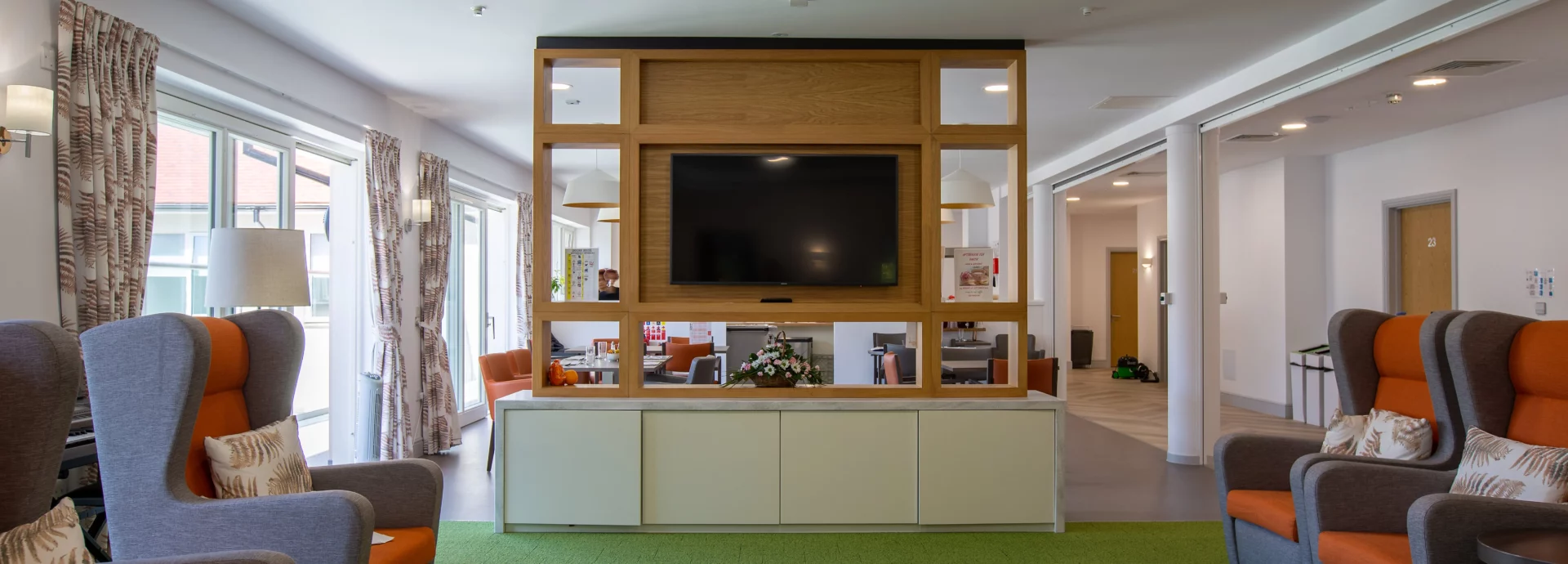
In This Article
Good care home interior design is essential to the happiness and wellbeing of every resident in every care home. Experienced…
Good care home interior design is essential to the happiness and wellbeing of every resident in every care home. Experienced staff and quality clinical care is still essential. But alone, it’s no longer enough to impress prospective residents and their families. To move forward from the challenges caused by COVID-19, care homes need new ways to stand out from their competitors and attract new residents.
Improving your care home interior design is a simple and effective way to do just that… As long as you can understand and use the 7 key principles of good design!
Jump Straight To –
- Space Considerations
- Using Lines For Care Home Interior Design
- Balancing Form With Care Home Interior Design
- The Use of Light in Care Home Interior Design
- Colour Schemes For Care Home Interior Design
- Exploring Different Textures
- Different Patterns Based on Different Rooms
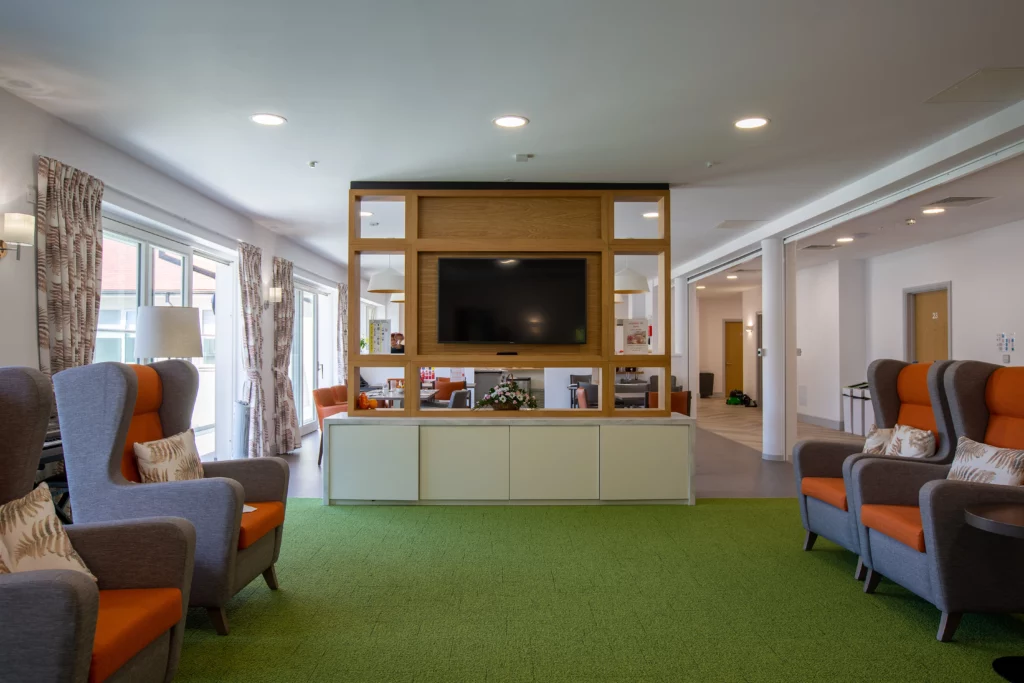
Spacious lounge area at the Eliza Palmer Hub at Whiteley Homes Trust.
What Are the 7 Principles of Care Home Interior Design?
Care home interior design is much more than just choosing a paint colour! There are seven key principles for creating a good design, every time:
Space Considerations
Space is one of the most important design elements for care homes.
It acts as a base for the entire environment. When designing your space, ensure that there is enough area for movement, access, and that residents will not feel closed in!
TIP: Rearranging the space can help reduce your ambulance callouts.
Making sure there’s enough functional, empty space minimises the number of trip hazards and helps prevent falls.
Using Lines For Care Home Interior Design
Lines offer a sense of harmony, contrast and unity within a care home environment.
They define forms (see principle 3) and offer visual guides. Lines are simple shapes, so they can give the residents something to rely on when moving around the home.
This is especially helpful for residents with visual impairments or dementia who may struggle with wayfinding.
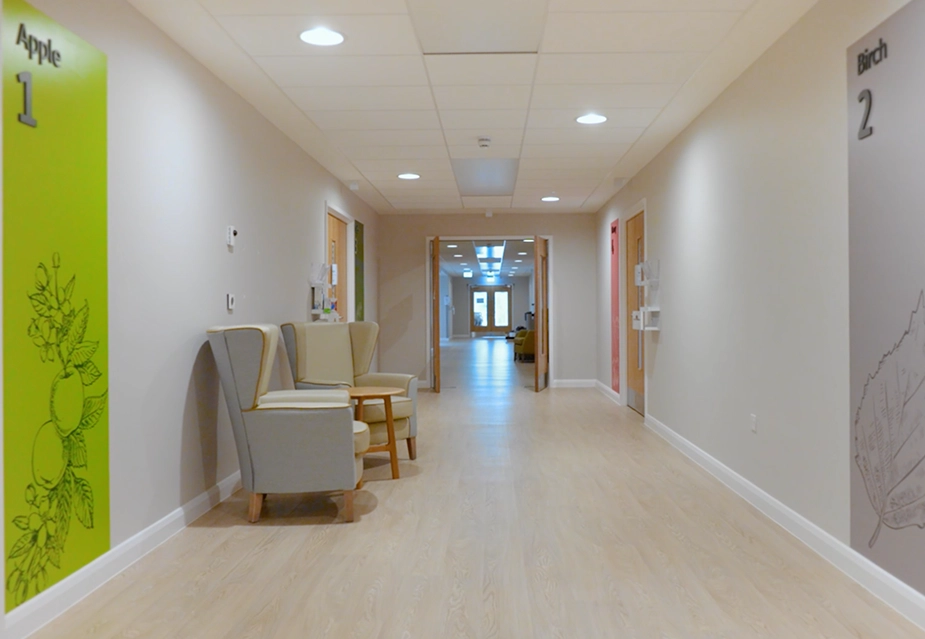
Many care environments are incorporating features to help deliver contrast with colours and shapes to support wayfinding.
TIP: Down a corridor, grab rails, wall panels, and photographs can all be used to create lines that emphasise the doorways.
Balancing Form With Care Home Interior Design
Form refers to the shape of the room, including any objects within it.
Basically, anything 3D is a form! Think beds, chairs, etc. There two main ways to categorise forms geometric vs. natural and open vs. closed.
Getting the balance right between these forms is key for creating a cohesive design that’s practical and looks great. An interior designer will be able to help you with this.
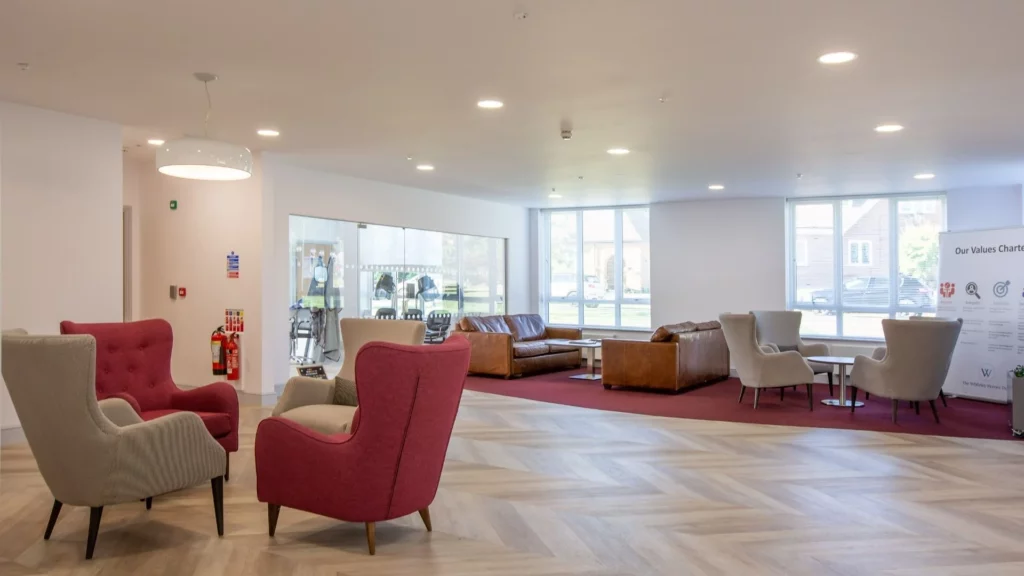
TIP: A wood-finish laminate is great for care homes. The wood effect looks natural and gives a more high-end look. But because it’s laminated it’s extremely easy to clean.
The Use of Light in Care Home Interior Design
Light is key within care home interiors, whether it’s natural or artificial.
The ageing eye needs reliable and consistent levels of lighting. So, the balance needs to be just right.
You always want to maximise your natural light. By using creative placement of doors and windows, you can allow more light into the room.
However, you will always need artificial lighting too. This will be made up of light fixtures to provide illumination and visibility. As well as lamps and spotlights to create atmosphere.
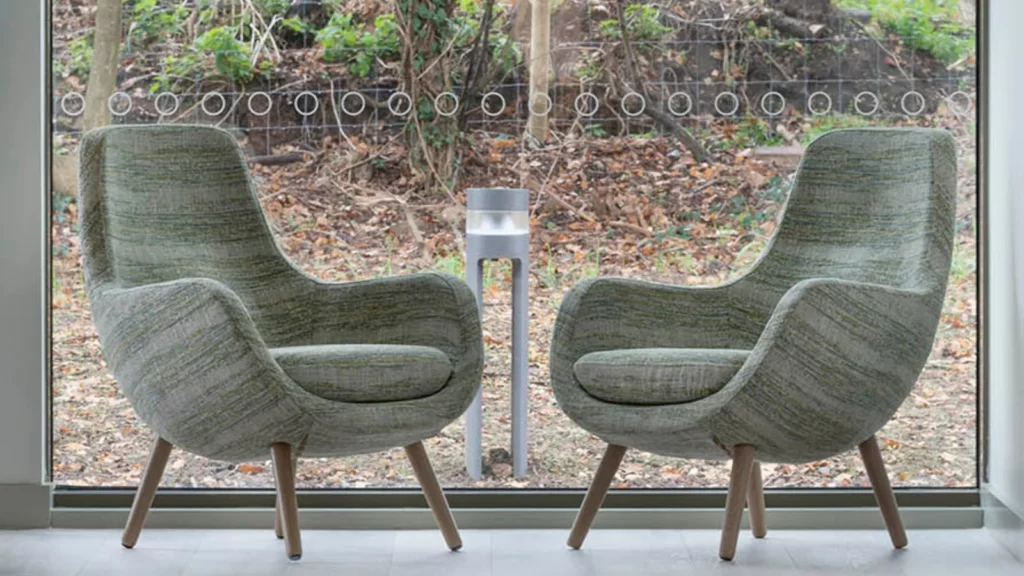
Bring in natural light wherever you can to support resident and staff wellbeing.
White light is good for functional rooms, like dining areas. Whereas warm lighting is often better for bedrooms where you want residents to relax.
TIP: Use several small low-intensity light fixtures rather than one large high-intensity light fixture. This helps to avoid glare which can disrupt residents’ vision, causing distress and discomfort.
Colour Schemes For Care Home Interior Design
Colour brings the ‘home’ into care homes. It’s one of the first things people think of when it comes to interior design. Plus, it’s one of the first things potential residents will notice when looking around!
The colours used should be subtle and dementia-friendly. It’s critical that colours have good contrast. For example, if a chair blends into the wall colour too much, there’s a higher risk of a resident falling when they go to sit down.
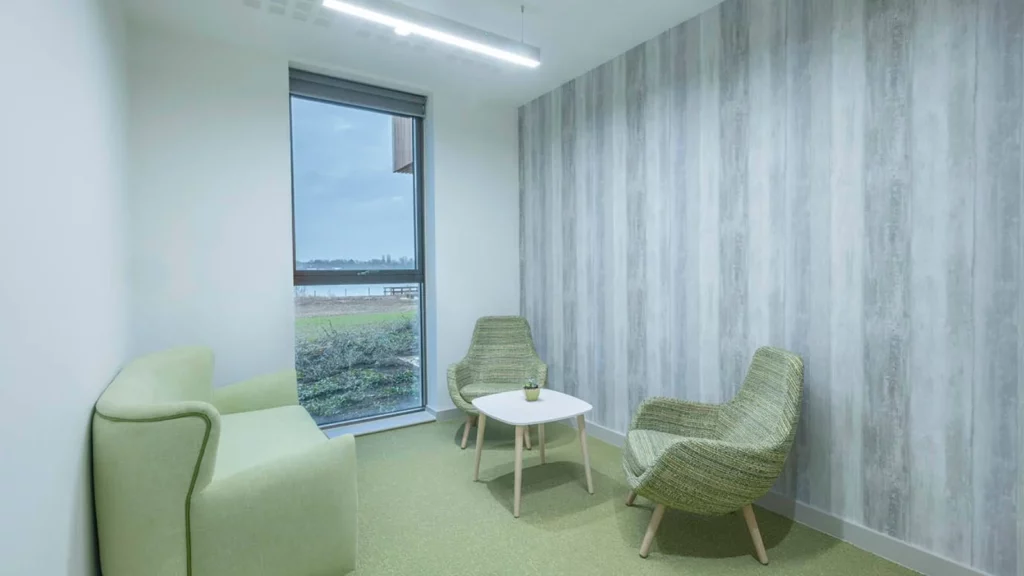
Having contrasting colours can make a huge difference, especially for residents who have dementia to help them with wayfinding.
Colours should also reflect the room’s function. For example, blues and neutrals are calming colours. So they are perfect for bedrooms. It helps the room feel like a relaxing, safe area.
We’ve got a whole article on colour theory to help you learn more!
TIP: Turquoise is considered to be an appetite stimulant. So, using turquoise plates in your dining room can help to improve residents eating!
Exploring Different Textures
Texture is an element of design that often gets overlooked. But it is important for tying a room together and ensuring it feels homely.
There is visual texture, which you can see e.g. wallpaper, and actual texture, which you can see and feel e.g. a soft cushion.
TIP: If you ever feel like there is ‘something missing’ in a room, generally it’s due to a lack of texture!
A good interior designer will advise on how to add texture to add the final piece of the puzzle and create an inviting environment.
Different Patterns Based on Different Rooms
Last but not least, pattern! Patterns are repetitive designs, often found in wallpaper and upholstery. Like texture, they add appeal to a room.
Different sized rooms require different types of patterns. Generally, larger rooms can handle more pattern. In a small room, too much pattern can be overwhelming.
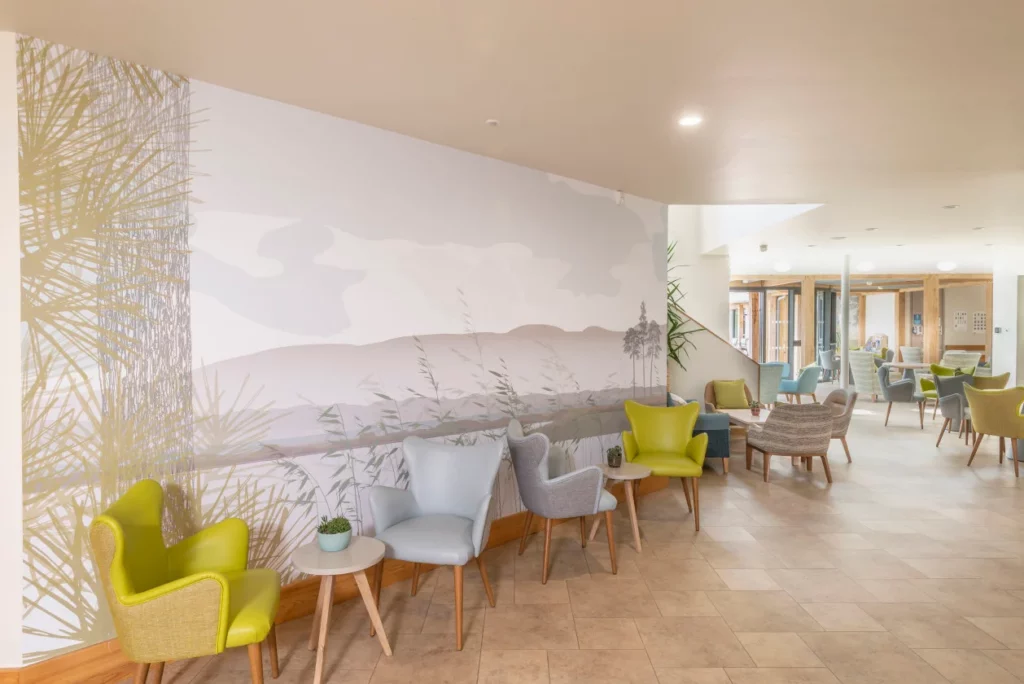
Large rooms can suit distinctive patterns, helping add appeal and making a room stand out.
The key for care homes is to stick to low contrasting patterns.
It’s also helpful to know the style category a certain pattern falls into. For example, you wouldn’t want an art deco style pattern in a traditional style room. It would ruin the overall concept style.
TIP: In dementia care settings, stripes need to be considered carefully, they can often be misinterpreted as barriers or bars.
Summary
Interior design is a key area for a care home group that wants to thrive. There’s such a range of improvements that can be made, from small changes to total makeovers. So, you can make it as simple or as large a job as you like. You can always go back and make more changes later when time/budget allows.
However, we would always recommend a professional interior designer to assist you in making these changes, large or small.
So many different areas come into play when caring for older people, including dementia and visual impairments. By getting professional help, you can make sure all design changes really do improve your care home. A small investment upfront can save money long-term by avoiding mistakes, increase your return on investment, and make your care home an enjoyable place for residents, staff and visitors alike.
If you need support for the design of your care environment, complete the contact form below to book in a call with our advisors.
Speak to The Experts
Need assistance with product enquiries, general inquiries, or product support? Our Phonelines are open 9am - 5pm Monday to Friday
0113 519 0319
Or, fill out the form for a call back.
